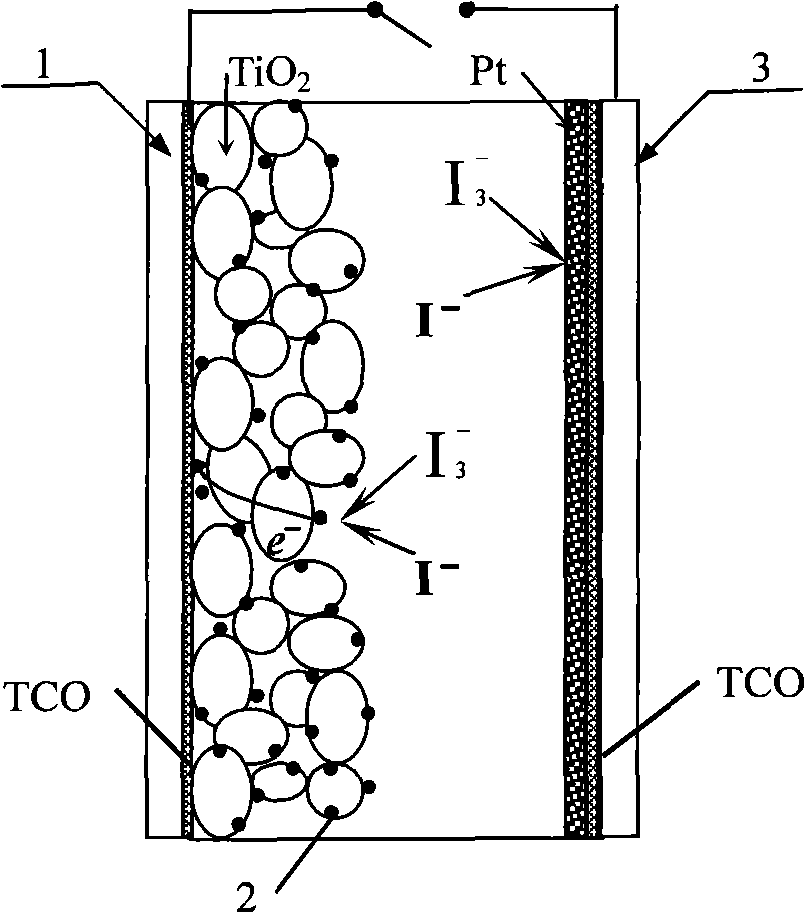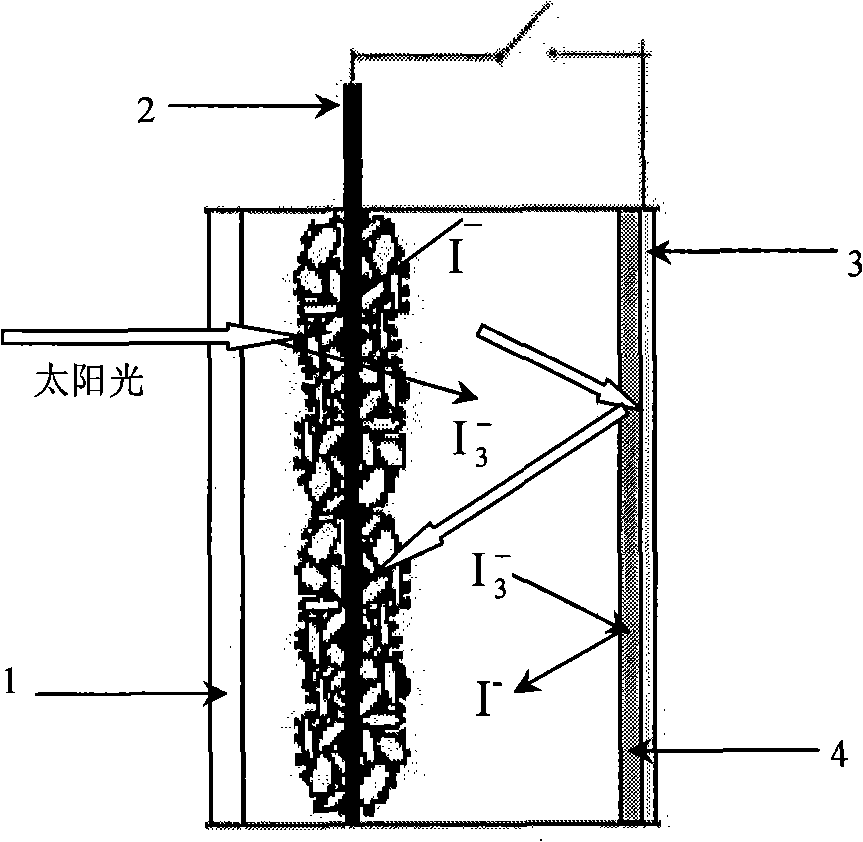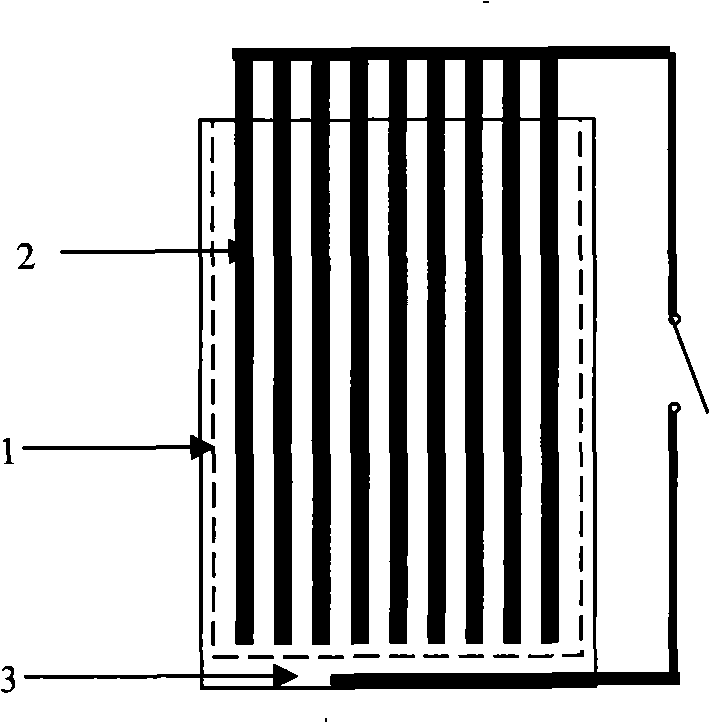Silk light anode integrated efficient electronic collection dye sensitized solar battery
A dye-sensitized, solar cell technology, applied in photovoltaic power generation, photosensitive equipment, electrolytic capacitors, etc., can solve the problem of increasing the light absorption of photoanode, and achieve the goal of increasing light absorption, collecting electrons, and increasing the effective light-receiving area. Effect
- Summary
- Abstract
- Description
- Claims
- Application Information
AI Technical Summary
Problems solved by technology
Method used
Image
Examples
Embodiment 1
[0023] Put 12 grams of commercial nano-titanium dioxide P25 powder produced by Degussa company in Germany into a mortar and grind, and add 4 ml of isopropanol solution containing 10% acetylacetone dropwise, and then add 10 ml of water dropwise to continue grinding, and mix 0.2 ml of of Triton X-100 was added to the suspension to prepare TiO with a concentration of 54.54% 2 sol.
[0024] A titanium wire with a diameter of 150 μm and a length of 1.3 cm is coated with a titanium oxide film with a thickness of 15 μm at a pulling speed of 10 mm per second by the pulling method, and a titanium wire of about 0.3 cm is reserved as a conductive electrode. Heat treatment for 30 minutes.
[0025] Put the coated titanium wire in a 3×10 -5 mol / L of N719 ruthenium organic dye in ethanol solution, heated to 80°C, soaked for 3 hours, taken out, washed with ethanol, and stored in a dry and dark environment.
[0026] Immerse the titanium metal sheet in 5 mmol / L H by pulling method 2 PtCl 6...
Embodiment 2
[0031] Put 250 mL of butyl titanate and 20 mL of isopropanol into a separatory funnel, add it dropwise to 1500 mL of deionized water containing nitric acid with a pH of 1 within 20 minutes, and stir vigorously. Continue stirring for 10 hours at ℃ to form transparent nano-TiO 2 colloidal solution, and then put it into a high-temperature and high-pressure reactor for constant temperature reaction at 230 ° C for 12 hours, and the prepared nano-TiO 2 The sol was concentrated to a concentration of 60% TiO by rotary evaporation 2 sol.
[0032] A tungsten metal wire with a diameter of 75 μm and a length of 5.2 cm was plated with a titanium oxide film with a thickness of 10 μm by screen printing, and a tungsten wire of about 0.2 cm was reserved as a conductive electrode, which was heat-treated at 500 °C for 1 hour.
[0033] Put the coated tungsten wire into a 5×10 -5 mol / L N719 ruthenium organic dye in ethanol solution, placed at room temperature for 72 hours, taken out, washed wit...
Embodiment 3
[0039] Mix 125 mL of isopropyl titanate and 20 mL of isopropanol evenly, put it into a separatory funnel, add dropwise to 750 mL of deionized water containing 5.3 mL of 70% nitric acid within ten minutes and stir vigorously, the mixture is at 80 ° C. Continue stirring for 8 hours to form transparent nano-TiO 2 colloidal solution, and then put it into a high-temperature and high-pressure reaction kettle for 12 hours at a constant temperature of 200 °C, and the prepared nano-TiO 2 The sol was concentrated to a concentration of 45% TiO by rotary evaporation 2 sol.
[0040] A 10-μm-thick titanium oxide film was placed on a nickel wire with a diameter of 100 μm and a length of 2.3 cm by screen printing, and a nickel wire of about 0.3 cm was reserved as a conductive electrode. Heat treatment at 500 ° C for 1 hour.
[0041] Put the coated nickel wire into the 5×10 -5 mol / L N719 ruthenium organic dye in ethanol solution, placed at room temperature for 72 hours, taken out, washed wi...
PUM
| Property | Measurement | Unit |
|---|---|---|
| Film thickness | aaaaa | aaaaa |
Abstract
Description
Claims
Application Information
 Login to View More
Login to View More - R&D
- Intellectual Property
- Life Sciences
- Materials
- Tech Scout
- Unparalleled Data Quality
- Higher Quality Content
- 60% Fewer Hallucinations
Browse by: Latest US Patents, China's latest patents, Technical Efficacy Thesaurus, Application Domain, Technology Topic, Popular Technical Reports.
© 2025 PatSnap. All rights reserved.Legal|Privacy policy|Modern Slavery Act Transparency Statement|Sitemap|About US| Contact US: help@patsnap.com



